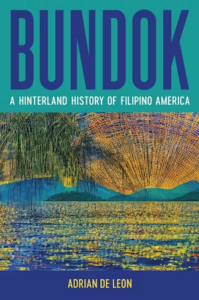We hope that you can join us for “Diaspora’s Boondocks: Hinterlands in Filipino American History on November 4.
This curated list has recommendations of books related to the topic of our talks.
Thanks to our partnership with Charm City Books, an independent bookstore located in the Seton Hill neighborhood of Baltimore, we are offering 10% off for any of the books on our suggested reading list. If you are purchasing online – whether directly from their website or bookshop.org – you can use discount code DELEON10. If you are purchasing in-person, please make sure you mention that the Dresher Center for the Humanities sent you.
Insurrecto by Gina Apostol
 Two women, a Filipino translator and an American filmmaker, go on a road trip in Duterte’s Philippines, collaborating and clashing in the writing of a film script about a massacre during the Philippine-American War. Chiara is working on a film about an incident in Balangiga, Samar, in 1901, when Filipino revolutionaries attacked an American garrison, and in retaliation American soldiers created “a howling wilderness” of the surrounding countryside. Magsalin reads Chiara’s film script and writes her own version. Insurrecto contains within its dramatic action two rival scripts from the filmmaker and the translator–one about a white photographer, the other about a Filipino schoolteacher.
Two women, a Filipino translator and an American filmmaker, go on a road trip in Duterte’s Philippines, collaborating and clashing in the writing of a film script about a massacre during the Philippine-American War. Chiara is working on a film about an incident in Balangiga, Samar, in 1901, when Filipino revolutionaries attacked an American garrison, and in retaliation American soldiers created “a howling wilderness” of the surrounding countryside. Magsalin reads Chiara’s film script and writes her own version. Insurrecto contains within its dramatic action two rival scripts from the filmmaker and the translator–one about a white photographer, the other about a Filipino schoolteacher.
Within the spiraling voices and narrative layers of Insurrecto are stories of women–artists, lovers, revolutionaries, daughters–finding their way to their own truths and histories. Using interlocking voices and a kaleidoscopic structure, the novel is startlingly innovative, meditative, and playful. Insurrecto masterfully questions and twists narrative in the manner of Italo Calvino’s If on a Winter’s Night a Traveler, Julio Cortázar’s Hopscotch, and Nabokov’s Pale Fire. Apostol pushes up against the limits of fiction in order to recover the atrocity in Balangiga, and in so doing, she shows us the dark heart of an untold and forgotten war that would shape the next century of Philippine and American history.
Bundok: A Hinterland History of Filipino America by Adrian De Leon
 From the late eighteenth century, the hinterlands of Northern Luzon and its Indigenous people were in the crosshairs of imperial and capitalist extraction. Combining the breadth of global history with the intimacy of biography, Adrian De Leon follows the people of Northern Luzon across space and time, advancing a new vision of the United States’s Pacific empire that begins with the natives and migrants who were at the heart of colonialism and its everyday undoing. From the emergence of Luzon’s eighteenth-century tobacco industry and the Hawaii Sugar Planters’ Association’s documentation of workers to the movement of people and ideas across the Suez Canal and the stories of Filipino farmworkers in the American West, De Leon traces “the Filipino” as a racial category emerging from the labor, subjugation, archiving, and resistance of native people.
From the late eighteenth century, the hinterlands of Northern Luzon and its Indigenous people were in the crosshairs of imperial and capitalist extraction. Combining the breadth of global history with the intimacy of biography, Adrian De Leon follows the people of Northern Luzon across space and time, advancing a new vision of the United States’s Pacific empire that begins with the natives and migrants who were at the heart of colonialism and its everyday undoing. From the emergence of Luzon’s eighteenth-century tobacco industry and the Hawaii Sugar Planters’ Association’s documentation of workers to the movement of people and ideas across the Suez Canal and the stories of Filipino farmworkers in the American West, De Leon traces “the Filipino” as a racial category emerging from the labor, subjugation, archiving, and resistance of native people.
De Leon’s imaginatively constructed archive yields a sweeping history that promises to reshape our understanding of race making in the Pacific world.
A History of the Philippines: From Indios Bravos to Filipinos by Luis H. Francia
 From ancient Malay settlements to Spanish colonization, the American occupation and beyond, A History of the Philippines recasts various Philippine narratives with an eye for the layers of colonial and postcolonial history that have created this diverse and fascinating population.
From ancient Malay settlements to Spanish colonization, the American occupation and beyond, A History of the Philippines recasts various Philippine narratives with an eye for the layers of colonial and postcolonial history that have created this diverse and fascinating population.
A History of the Philippines begins with the pre-Westernized Philippines in the 16th century and continues through the 1899 Philippine-American War, the nation’s relationship with the United States’ controlling presence, culminating with its independence in 1946 and two ongoing insurgencies, one Islamic and one Communist.
Luis H. Francia creates an illuminating portrait that offers the reader valuable insights into the heart and soul of the modern Filipino, laying bare the multicultural, multiracial society of contemporary times.
Letters to a Young Brown Girl by Barbara Jane Reyes
 Barbara Jane Reyes answers the questions of Filipino American girls and young women of color with bold affirmations of hard-won empathy, fierce intelligence, and a fine-tuned B.S. detector. The Brown Girl of these poems is fed up with being shushed, with being constantly told how foreign and unattractive and unwanted she is. She’s flipping tables and throwing chairs. She’s raising her voice. She’s keeping a sharp focus on the violences committed against her every day, and she’s writing through the depths of her “otherness” to find beauty and even grace amidst her rage. Simultaneously looking into the mirror and out into the world, Reyes exposes the sensitive nerve-endings of life under patriarchy as a visible immigrant woman of color as she reaches towards her unflinching center.
Barbara Jane Reyes answers the questions of Filipino American girls and young women of color with bold affirmations of hard-won empathy, fierce intelligence, and a fine-tuned B.S. detector. The Brown Girl of these poems is fed up with being shushed, with being constantly told how foreign and unattractive and unwanted she is. She’s flipping tables and throwing chairs. She’s raising her voice. She’s keeping a sharp focus on the violences committed against her every day, and she’s writing through the depths of her “otherness” to find beauty and even grace amidst her rage. Simultaneously looking into the mirror and out into the world, Reyes exposes the sensitive nerve-endings of life under patriarchy as a visible immigrant woman of color as she reaches towards her unflinching center.
Noli Me Tangere (Touch Me Not) by José Rizal
 In more than a century since its appearance, José Rizal’s Noli Me Tangere has become widely known as the great novel of the Philippines. A passionate love story set against the ugly political backdrop of repression, torture, and murder, “The Noli,” as it is called in the Philippines, was the first major artistic manifestation of Asian resistance to European colonialism, and Rizal became a guiding conscience–and martyr–for the revolution that would subsequently rise up in the Spanish province.
In more than a century since its appearance, José Rizal’s Noli Me Tangere has become widely known as the great novel of the Philippines. A passionate love story set against the ugly political backdrop of repression, torture, and murder, “The Noli,” as it is called in the Philippines, was the first major artistic manifestation of Asian resistance to European colonialism, and Rizal became a guiding conscience–and martyr–for the revolution that would subsequently rise up in the Spanish province.
Translated from the Spanish by Harold Augenbraum
Concepcion: Conquest, Colonialism, and an Immigrant Family’s Fate by Albert Samaha
 A journalist’s powerful and incisive account reframes how we comprehend the immigrant experience.
A journalist’s powerful and incisive account reframes how we comprehend the immigrant experience.
Nearing the age at which his mother had migrated to the US, part of the wave of non-Europeans who arrived after immigration quotas were relaxed in 1965, Albert Samaha began to question the ironclad belief in a better future that had inspired her family to uproot themselves from their birthplace. As she, her brother Spanky–a rising pop star back in Manila, now working as a luggage handler at San Francisco airport–and others of their generation struggled with setbacks amid mounting instability that seemed to keep prosperity ever out of reach, he wondered whether their decision to abandon a middle-class existence in the Philippines had been worth the cost.
Tracing his family’s history through the region’s unique geopolitical roots in Spanish colonialism, American intervention, and Japanese occupation, Samaha fits their arc into the wider story of global migration as determined by chess moves among superpowers. Ambitious, intimate, and incisive, Concepcion explores what it might mean to reckon with the unjust legacy of imperialism, to live with contradiction and hope, to fight for the unrealized ideals of an inherited homeland.